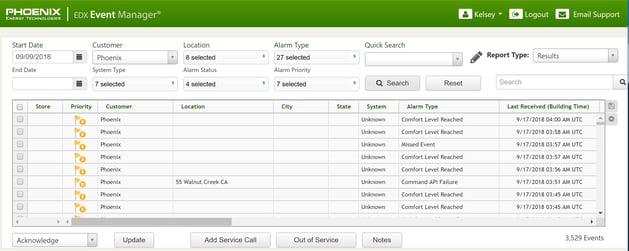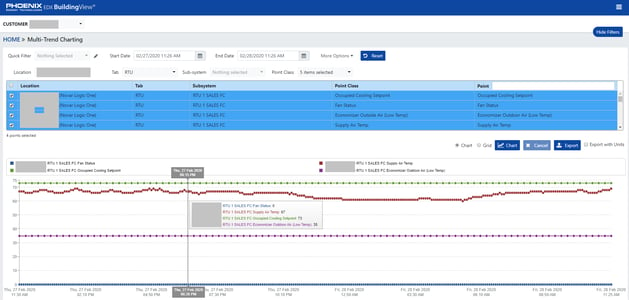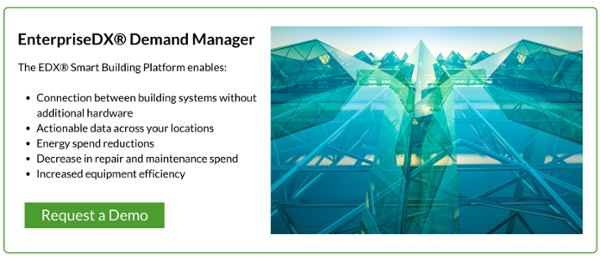Share this
How to Centralize Site-Level Data to Optimize EMS Alarms
by Phoenix Energy Technologies on Dec 6, 2021
A look at how you can optimize your energy management system (EMS) alarms through centralized management and smart IoT tools, creating efficiencies and precision that saves you money.
Managing Building Alarms
Building alarms serve critical functions, particularly as facility and energy managers manage multiple locations off-site. Unfortunately, it is typical for managers to be inundated with many alarms and face prioritizing issues or receive alarms that do not require their attention. These issues waste time and money with managers trying to figure out where - or if - to focus their attention at a given moment.
Building Alarm Basics
A Building Management System (BMS) relies on multiple control systems and alarms that become triggered when a value ranges above or below normal operating conditions. During an average day, a BMS may experience hundreds of alarms.
The design and operation of building EMS alarms encompasses the crucial purpose of preventing or mitigating abnormal conditions that could cause physical or economic loss. When an alarm occurs, the system notifies an operator that a fault exists. Mitigating the abnormal condition depends on decisions made by the operator.
However, gaps can occur. Without proper design, an alarm management system may permanently throw “nuisance” alarms. Or one abnormal condition may trigger multiple, redundant alarms. Using temperature alarms as an example, the opening and closing of a store entrance door can create a change in indoor temperatures that cause an alarm to trigger on and off. Although a sensor has detected an abnormal situation – a fluctuation in room temperature – the lack of self-diagnostics describing the possible reasons for the alarm or any potential impacts on system performance exposes the possibility of human error.
Without determining proper causes for alarms, operators cannot make definitive decisions about operations, maintenance, or customer comfort. As a result, alarms can become “the boy who cried wolf,” causing actual fault conditions to not gain the necessary attention from facility managers.
Maintenance Program Options & Implementing A Predictive Program
IoT-powered BMS Provides Insight
Traditional decentralized models for facilities management supporting HVAC, electrical, plumbing, and other major assets involve a separate organizational structure for each area. Each group typically has maintenance teams, supply systems, and fleets. Rather than work with data that holistically encompasses a facility, a BMS working within the decentralized model only handles data for a specific area. Levels of alarm management and maintenance then vary with each organizational structure as managers and operators handle different control systems, attempt to view and analyze different front ends, and face the complexity of prioritizing alarms.
IoT-powered Building Management Systems offer an alternative to reactive support by centralizing site-level data through consistent standards and procedures. As an IoT-powered BMS monitors conditions, sensing technologies assist with maintaining the efficient operations of HVAC, lighting, electrical, and refrigeration systems along with industrial and customer-facing equipment. Optimizing building performance occurs through the connectivity between sensors and BMS servers through IP-based networks.
A Centralized Approach
Decentralized site data leaves operators searching through pages of flow charts and other information in an attempt to prioritize alarms. A centralized IoT-based approach to site data gives facility managers and operators a distinct advantage.
A centralized approach utilizes BMS software to analyze big data from sensors connected to many different points of larger systems housed across multiple facilities in various geographic areas. HVAC thermostats and controller sensors produce a variety of control signals while monitoring temperature, fan speeds, humidity, and the action of actuators and dampers. Peripheral sensors control energy consumption and ensure customer comfort through connections to lighting systems, doors, and windows. Condition sensors monitor temperature, humidity, air pressure, and air quality in offices, retail stores, healthcare facilities, and apartments.
Rather than rely on gateways or hubs, IP-based IoT devices directly connect devices to sensors and systems. An IP-based IoT network operates independently of the public internet and corporate IT networks while accessing physical networking technologies and utilizing application protocols.
Scalability, Versatility, and Interoperability Ease Decision-making
Intelligent BMS support decision-making by managers while regulating and controlling facility subsystems. Constant data mining by Software-as-a-Service (Saas) applications tracks and consolidates alarms by status into duplicate, resolved, recurring, and urgent categories.
Fault detection and failure prediction algorithms perform root cause analysis of faults, prioritizing alarms according to business rules. The best response to each alarm is then calculated and transmitted for timely and decisive action. Alarm management through an intelligent BMS makes the task easier, precise, and timely.
Facility and energy managers benefit from viewing alarm conditions through a single, centralized interface. Real-time dashboards share data across facilities, show relevant searches, and provide filter options for customized alarm views. Dashboard functionality also allows managers to add comments to an alarm to show the status or to guide technicians.
A centralized approach allows managers to sort through different control systems and front ends while efficiently prioritizing the most critical alarms. Knowing what to manage across all assets results in reduced downtime and fewer significant issues to address.
Smart Building Platform Defines Quality for Facilities Management
Phoenix's powerful BMS platform, Enterprise Data Xchange® (EDX), utilizes IoT to optimize building performance and centralizes data capture and analysis to establish high-quality alarm management and maintenance for HVAC, lighting, refrigeration, and other assets located within multiple facilities.
Phoenix's EDX® Event Manager further enhances manager and operator performance by combining all control systems into one at-a-glance dashboard. Managers can quickly gain insight into system wide information and make decisions about all types of alarms firing simultaneously from different locations.

Multiple Flags and Priorities to Manage Alarms, EDX Event Manager
How it Works
When alarms fire across your enterprise, EDX® Event Manager allows personnel to click on an alarm to access real-time unit operating information. With the use of EDX® Building View, managers can remotely inspect a facility and find a problem source. A manager or operator can use reports to determine the alarm's severity and check sensor functionality. If EDX Event Manager detects multiple alarms for a particular location, managers and operators can analyze potential problems at the control system level and assign technicians to check the system.

Command Set Points for Individual Locations or Groups, EDX Building View
The versatility of EDX® Event Manager also ensures customer satisfaction. Given the information produced by Event Manager and its connection to predictive and proactive maintenance, technicians can reduce the time needed to troubleshoot calls and find solutions to problems. Minimizing decision points at the technical level allows technicians to restore normal operating conditions quickly.
Request an EDX Demo
Let Phoenix help you with your energy and facility management goals!
Whether you have specific energy demand or cost targets, or long-term sustainability goals, reach out to our experts for an enterprise energy assessment to see how EDX tools and reporting can get you started on managing your locations with real-time data and support!
Share this
- Facilities Management (77)
- Energy Management (57)
- Company News (36)
- Retail (34)
- Smart Buildings (33)
- Building Management (24)
- Building Automation Systems (19)
- Energy Demand Management (19)
- Sustainability (15)
- demand response (13)
- Adaptive Energy Management (12)
- EEI (12)
- Artificial Intelligence (10)
- Grocery (10)
- COVID-19 (8)
- Customer Spotlight (8)
- Carbon Management (7)
- Setpoints and Temperatures (7)
- Equipment Maintenance (6)
- Finance and Procurement (5)
- IoT and Digital Transformation (5)
- Safety and Compliance (4)
- Ask Ron (3)
- Awards (3)
- Energy Management System (3)
- Operational Efficiency (3)
- ConnexFM (2)
- Load Shedding (2)
- Customer Service (1)
- April 2024 (2)
- March 2024 (2)
- January 2024 (1)
- December 2023 (1)
- October 2023 (2)
- September 2023 (2)
- August 2023 (2)
- July 2023 (1)
- May 2023 (2)
- April 2023 (2)
- March 2023 (3)
- February 2023 (1)
- January 2023 (1)
- December 2022 (1)
- November 2022 (2)
- October 2022 (2)
- September 2022 (1)
- May 2022 (2)
- April 2022 (1)
- March 2022 (3)
- February 2022 (2)
- January 2022 (4)
- December 2021 (2)
- November 2021 (3)
- October 2021 (1)
- September 2021 (3)
- August 2021 (4)
- July 2021 (1)
- June 2021 (2)
- May 2021 (1)
- January 2021 (2)
- December 2020 (2)
- November 2020 (2)
- October 2020 (3)
- September 2020 (4)
- August 2020 (3)
- July 2020 (2)
- June 2020 (3)
- May 2020 (3)
- April 2020 (5)
- March 2020 (5)
- February 2020 (4)
- January 2020 (4)
- December 2019 (4)
- November 2019 (3)
- October 2019 (4)
- September 2019 (5)
- August 2019 (4)
- July 2019 (4)
- May 2019 (2)
- April 2019 (3)
- February 2019 (1)
- December 2018 (1)
- November 2018 (1)
- October 2018 (3)
- September 2018 (3)
- August 2018 (3)
- July 2018 (3)
- June 2018 (3)
- May 2018 (1)
- June 2015 (1)
- March 2013 (1)
- January 2013 (1)
- December 2011 (1)
- October 2011 (1)
- September 2011 (1)


